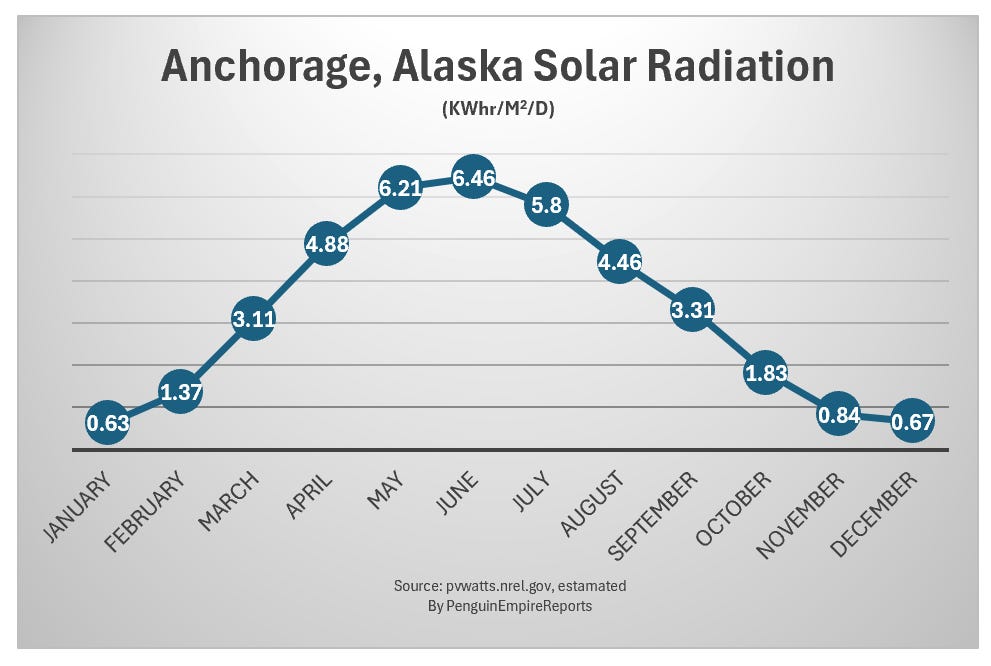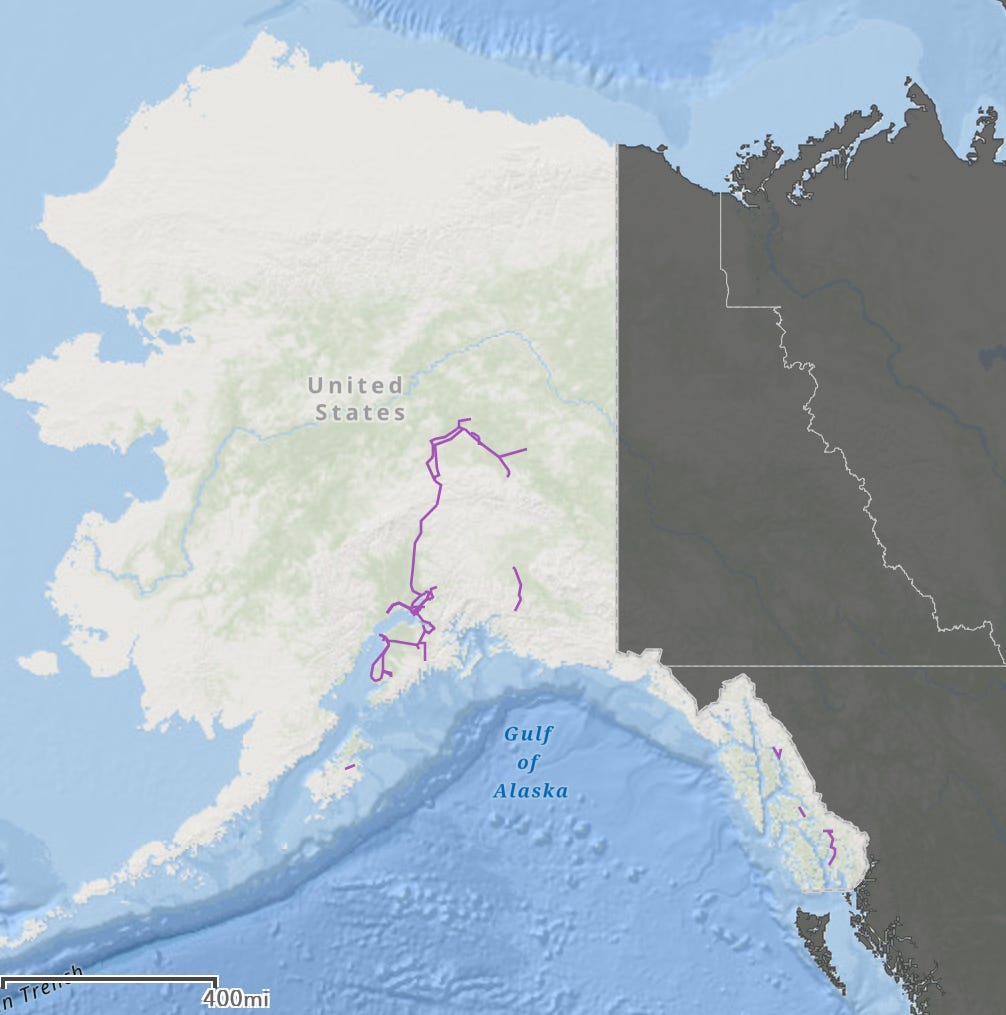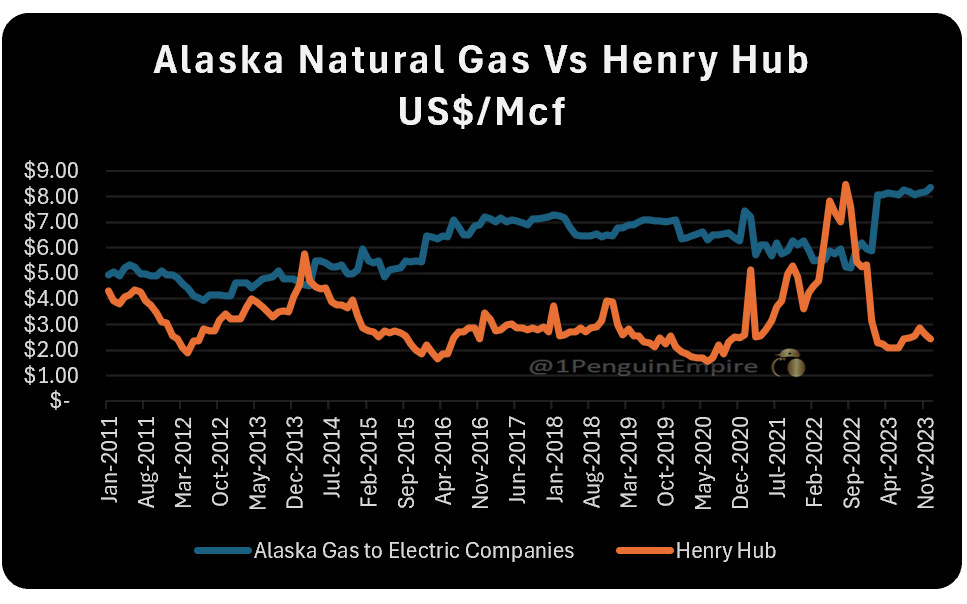Does Alaska's Solar Make Sense?
Alaska recently brought online its largest solar farm, an 8.5 MW facility. We'll compare solar in Alaska to coal and natural gas.
Imagine you’re stranded at an airport during a winter storm and the screens only show ‘Cancelled’ flights. Does it help you to know that last week, there were plenty of flights with seats available? Probably not. What matters is that there’re flights with seats available when you need them.
It’s a similar story with electricity.
We Don’t Care About Electricity As Much As We Care About Reliable Capacity.
Electricity doesn’t come from the outlet. It is the result of something else. In many ways, electricity is just the middleman: it’s the ‘thing’ that bridges distances to instantly connect you to an available power source. Without that connection to constant generation in real time, electricity dies a very sudden death.
When you use electricity, in essence you’re ‘renting’ generation capacity, in real time. What we care about is having a connection to an available generator when you need it. If ‘space’ on a generator isn’t available to ‘rent’ when you need power, then too bad, so sad.
So when deciding the best way to build a grid, it is not really a question of how to provide electricity. In stead, it’s a question of how to best line-up and connect to safe, reliable, and available generating capacity. If we do that correctly, then electricity flows as a result.
With that in mind, let’s take a trip over to Alaska.
Alaska and Solar
Known as “The Last Frontier,” Alaska is really BIG. At approximately 586,000 square miles, it is roughly the size of Germany, Spain, France, and Portugal combined. This immense state stretches over 2000 miles at its widest and over 1400 miles at its longest, reaching all the way up to the Arctic Circle.
Because Alaska is so far north, it has very long summer days and extremely long winter nights. The farther north you go, the more extreme it gets. For example, in Anchorage (the most populated town, located in the central south) sunrise in January is around 10 am. Around 4pm, the sun sets. However, in June, the sunrise is ~ 4-4:30 am and doesn’t set until almost midnight. But if you go to the north end of the state (Barrow/Utqiagvik) the sun never really sets in June. Up there in January, you might get a hazy twilight between 11am and 4pm, but you don’t get a real sunrise.
The radical changes in sunlight can be shown in a chart of average solar radiation in Anchorage, Alaska. In June, you’ll get about 10x the amount of solar radiation as you would in January. Of course, this is just an average, without considering cloudy days.
Late last year, Alaska’s largest solar farm started operations. At 8.5MWs, it’s tiny compared to the 400, 500, and even nearly 800 MW scale farms in Texas, California, and Nevada. But 8.5MW is the biggest in Alaska, built in the outskirts of Anchorage, in a place (ironically) named Houston, a small town with around 2000 residents.
So is it a good idea? Setting aside the enormous federal government subsidies that can cover 30-40% + of the construction costs for new solar, is it right for Alaska?
It goes without saying, but… Alaska gets cold in winter. Anyplace known for glacier tourism isn’t exactly…warm. Unfortunately for solar in Alaska, it’s most productive in summer, and almost nowhere to be seen (literally) during those long winter nights.

But the energy space is a bit like a Jerry Springer Show: it’s complicated.
The Alaska Energy Dichotomy.
While Alaska has vast oil, coal, hydro and gas resources, it has expensive energy. For much of Alaska, there is no electrical grid connecting the scattered towns and villages. Many of those small towns rely on a local oil-fuled power plant with no outside grid connections. Almost all of the transmission lines (purple lines in the map below from the EIA) are in the “Railbelt” area connecting Anchorage to the central part of the state.
Alaska has even less gas pipeline infrastructure, with almost all of it located in the Anchorage area in the south/central part of the state. And Anchorage area gas comes from the Cook Inlet.
Cook Inlet has produced since the 1960s. In its heyday, Cook Inlet produced large quantities of gas, enough to support a 1.8BCF LNG export facility and one of the nation’s largest fertilizer plants at Kenai (~2million metric tons/yr capacity). But over time, the cheap gas was drilled up in Cook Inlet and prices started to climb. By 2007, the fertilizer plant shuttered, followed by the LNG export plant’s closure and sale. The new owners of the LNG plant applied for a DOE import license to potentially switch the plant to an import facility.
Here is a chart from the Alaska Energy Authority, showing Cook Inlet’s steep decline since 2000.
This does NOT mean that the gas is all gone.
Hilcorp is the company that produces the overwhelming majority of the Inlet’s gas. Hilcorp has been accused of holding down production to keep prices high. While many national-level Democrats have aligned themselves against the “drill baby, drill” crowd, a number of Alaska’s Democrat state legislators wrote a letter to the Attorney General, accusing Hilcorp of not drilling enough. According to the letter dated Nov 6, 2023:
“Hilcorp earned nearly a half-billion dollars from Cook Inlet gas last year, and the United States Geological Survey has found that Cook Inlet gas can likely be economically recovered with current technology sufficient to meet…needs for the next two centuries. Unfortunately, Hilcorp appears to be using its monopoly position in Cook Inlet to artificially restrict the supply… To date your office has not taken enforcement action to compel Hilcorp to produce gas from state lands in accordance with existing state law.” (emphasis added.)
While it is true that the Inlet likely still holds vast amounts of gas, it might be more expensive to get it. According to a 2018 estimate by the Alaska Department of Natural Resources, Cook Inlet could produce significantly more gas if prices stay elevated in the $6-$8/mcf range.
To add another wrinkle to the plot, the North Slope of Alaska produces large amounts of oil and gas. While there’s a major oil pipeline running down from the north, there’s no such gas pipeline. The gas produced there is trapped: it’s either used locally or it’s pumped back underground to pressurize the oil fields, with some LNG to be trucked to the interior of the state. There is a proposed gas pipeline backed by the state government. However, it’s only been a couple of decades into the planning process so we’ll see if it ever comes online.
A potentially new source of gas may be imported LNG. Canada is constructing an LNG export facility at Kitmat, British Colombia. At more than 85% complete, the facility is scheduled to come online in 2025.
Yet for now, in the most populated part of the state (the Anchorage area), natural gas prices are high, ~ 3-5x the price of gas at Henry Hub near the US Gulf Coast, according to the EIA.
Potential Fuel Savers
While solar in Alaska cannot replace reliable capacity, under the right circumstances it can save fuel costs if fuel prices remain high.
For example, if you have a remote cabin that you mainly use in summer, solar might be a good option to save fuel, especially if you have to bring fuel in on an ATV and if your primary heating and cooking fuels come from wood, found nearby.
But what if you have to provide electricity 24/7 all year? You still need the reliable capacity, but solar can potentially act as a fuel saver during the summer months, depending on the power plant type.
There are several broad types of natural gas plants including:
Gas turbines, similar to jet engines that run at 25-35% efficiency. However, they can respond quickly to demand changes
Internal combustion engines similar to giant ship engines: Wartsila’s best in class engines can operate in the 40% - 49.4% efficiency range.
Combined-cycle gas plants are better suited for long, steady operations. They use gas turbines to produce some electricity and capture the ‘waste’ heat to make steam. That steam is used to make additional electricity. The plants run at 50-60s% efficiency.
Coal plants in the US tend to operate around 30-35% efficiency, according to the EIA. However, one of the downsides of the Net Zero push is that we’re not developing more efficient coal plants. But China is. In late 2022, China’s Pingshan Phase II plant hit a record thermal efficiency for a coal plant at 49.37%.
An exception to that rule is in Alaska. In 2018, the US’s newest coal plant (17MW) was brought online at The University of Alaska, Fairbanks. It’s a small plant that produces electricity and then uses the steam to heat buildings during the long cold winters. This combined heat/electricity output is nearly 70% efficient. And not to miss a good opportunity, the University got a grant from the federal government to study carbon capture on coal plants. That’s a win-win for the school: get cheap power and get subsidized to study it.
Outside of the University, the town of Fairbanks also has a similar, co-generation system, providing electricity, steam for heat, and even hot water to the town. These aren’t the only coal plants in Alaska but they provide an interesting look at how geography, weather, and infrastructure can dictate what technology is used in a region.
While many in Washington and the EPA might celebrate new regulations to kill off existing coal plants, gas isn’t an option for everyone in Alaska because of the lack of pipelines and the high costs. Some gas plants can buy expensive LNG trucked-in. But for parts of the state, coal can be cheaper than gas.
In fact, in February of 2024, the University of Alaska publish a study, suggesting that the most economic solution to the Cook Inlet gas problem may be to build new coal generation with carbon capture. Ironically, the University estimates that new coal generators could make money off of the carbon capture tax credits of $85/tonne of CO2 under the Inflation Reduction Act:
Biomass-coal energy supply with CCS (carbon capture) provides lower cost energy than natural gas energy supply with or without CCS… Further, CCS lowers the cost of electricity for biomass-coal generation because 45Q tax credit revenues exceed CCS cost… As the imminent gas supply shortfall further increases natural gas prices, gas-based electricity, with or without CCS, is more expensive than biomass-coal-based electricity with CCS. (emphasis added)
And where does the University suggest storing that CO2? - the depleted gas fields of Cook Inlet.
And for those interested, $85/tonne CO2 works at to a theoretical max of $8.25 per MMbtu of Alaskan coal. And coal in Alaska currently sells for around $4.38 per MMbtus. Yes, you read that right, President Biden’s IRA carbon credit can be up to 2x the price of the underlying fuel. Even if the carbon capture is only about 50% effective, it would be ~ equal to the price of coal.
And if you’re wondering if Alaska will run out of coal… According to Alaska’s DNR “Alaska's coal resources make up about half of the United States coal-resource base and approximately one-sixth of the world coal-resource base” with 160 billion short tons of identified resources. Of course, not all of that could be mined since large parts of the state are federal parks and lands.
AND… carbon capture is in its infancy so the costs of building and operating effective CCS at scale are TBD.
And while it is true that coal plants might be more expensive to build and operate than gas plants, in Alaska coal’s fuel costs are lower than gas, even without carbon capture tax credits, as shown in the table below (fuel costs only, excluding other operating costs and ramp up/down costs to accommodate solar).
And this brings us back to the idea that solar can sometimes save fuel costs.
How much does solar cost from the brand new Houston farm? Under a 25 year agreement, the farm sells electricity to the utility at approximately $0.067 per kWhr. So, solar can potentially save fuels if it temporarily take a low efficiency gas plant offline (that uses about $0.08-$0.11 worth of fuel per kWhr) in summer and bring it back online during winter as needed.
However, solar is pretty much awash or it can potentially drive up the cost of electricity if you have to take a steady-state, best in class combined cycle plant offline (using around $ 0.05-0.07/kWhr worth of fuel) to accommodate solar. In fact, forcing a combined cycle plant to go off line causes extra costs to ramp the plant up and down, which can wipe out any savings from using solar for brief periods of time.
But regardless of how much fuel you might save in summer, when winter roles around, solar is all but useless. Alaska desperately needs that reliable capacity when that life-threatening cold hits.
We’ll close by summarizing a few key points:
Electricity isn’t really about just electricity, it’s about available capacity
In Alaska, solar can’t replace reliable capacity but…
Solar might act as a fuel saver IF fuel is highly constrained and IF substitutes such as coal aren’t available
Without access to cheap natural gas, coal can be a competitive
Carbon capture tax credits ironically might make coal in Alaska more competitive
Local geography and infrastructure matters and a one sized-shoe approach doesn’t work for everyone.
As Always, Thanks For Reading!









Wow! Great article. You’ve connected a couple of dots for me that I have been missing. I’m from Anchorage, and work in Prudhoe Bay. I drive by the LNG plant Hilcorp is building regularly. I was fascinated to learn just how much coal Alaska has, and the efficiency of the new generation coal plants. It may be a naked subsidy grab as mentioned in the comment above, but UAF’s proposal to generate electricity with coal powered plants, and offset the costs with carbon capture, pumping the Co2 into the gas wells in Cook Inlet is genius. The pipeline infrastructure to transport Co2 from Anchorage to the wells already exists. Thanks for the article. You’ve gained a subscriber!
This is very interesting. The town of Inuvik, where my family lived in the 1970s, in Canada’s Northwest Territory, has been trucking diesel and LNG up the rough Dempster highway for more than a decade since a natural gas well that powered the town’s power plant depleted. They are currently working toward building a small LNG facility at the site of another gas well close to the town. Once completed the facility is expected to provide LNG to Inuvik and other communities in the region for the next 50 years. The power issues in the arctic are unique!